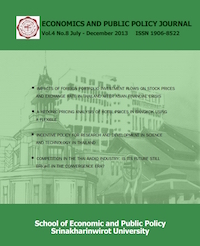Incentive Policy for Research and Development in Science and Technology in Thailand
Main Article Content
บทคัดย่อ
Research and development (R&D), a main core of technological development, and progress in technology are one of the most important factors for a country’s long-run economic development. In Thailand, however, the development in technology is struggling due to the low level of R&D investment generated by private firms compared to the firms in the highly-developed industrialized countries (e.g., South Korea, Japan, and the United States). Besides, Thailand’s overall value of R&D expenditure per GNP in the past decade is more or less stagnant and staying below the world’s median figure. This paper attempts to investigate the phenomenon and explain the causes of firms’ lack of incentive in R&D investment in which a comprehensive policy arrangement is suggested by focusing on the government’s role in promoting R&D investment incentive schemes. Findings cover multidimensional problems and solutions. First, The lack of researcher either public or private sector pose a serious issue on the human capital management in this country. The problem can be explained through the mismatch of demand and supply for researcher in the job market. The low rate of employed researchers to total workforce and the low rate of enrollment in the field of science and technology in the university create insufficient science and technology human resource. This obstructs the technological progress as well as deterring the sustainability of the country’s economic growth. In order to tackle the problems, the Thai government issued two national schemes namely “R&D tax incentive” and “university research fund” aiming to promote the level of R&D investment of the private firms and demand for researchers of the domestic university. Though the main weaknesses of the schemes stems from their inefficient regulation and budget management, due to these two policies, during 2007 – 2009, the number of researchers in both public and private sectors increased by 37 percent, approximately. To go beyond the conventional policy framework, the next issue discusses a topic of “inspiration in R&D investment and growth in R&D sector” which is an idea that can lead to alternative framework for the policymaker for creating R&D incentive.
Article Details
บท
บทความวิจัย
สงวนลิขสิทธิ์ © 2553 คณะเศรษฐศาสตร์ มหาวิทยาลัยศรีนครินทรวิโรฒ
คณะเศรษฐศาสตร์ มหาวิทยาลัยศรีนครินทรวิโรฒ จัดพิมพ์วารสารเศรษฐศาสตร์และนโยบายสาธารณะ เพื่อเผยแพร่บทความวิชาการทางเศรษฐศาสตร์ นโยบายสารธารณะ และสาขาอื่นๆที่เกี่ยวข้อง ทัศนะและข้อคิดเห็นใดๆ ที่ปรากฏในวารสารเป็นความคิดเห็นส่วนตัวของผู้เขียน โดยบทความที่ได้รับการตอบรับจะถือเป็นลิขสิทธิ์ของคณะเศรษฐศาสตร์ มหาวิทยาลัยศรีนครินทรวิโรฒ
บรรณาธิการ ผู้ช่วยศาสตราจารย์ ดร.ณัฐญา ประไพพานิช

